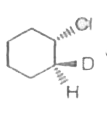In the following questions, a statement of assertion (A) is following by a statement of reason (R )
 is more reactive towards nucleophilic substitution reaction than
is more reactive towards nucleophilic substitution reaction than 
R: NO2 group is electron withdrawaing so decreases the double bond of C-CI bond .
If both Assertion & Reason are the reason is the correct explanation of the assertion, then mark (1).
If both Assertion & Reason are true but the reason is not the correct explanation of the assertion, then mark(2).
If Assertion is true statement but Reason is false , then mark (3)
If both Assertion and Reason are false statements, then mark (4)
The correct Answer is:C
Step by step video, text & image solution for In the following questions, a statement of assertion (A) is following by a statement of reason (R ) is more reactive towards nucleophilic substitution reaction than R: NO_(2) group is electron withdrawaing so decreases the double bond of C-CI bond . by Chemistry experts to help you in doubts & scoring excellent marks in Class 12 exams.
Updated on:21/07/2023Topper's Solved these Questions
- HALOALKANES AND HALOARENES BOOK - AAKASH INSTITUTECHAPTER - HALOALKANES AND HALOARENES EXERCISE - ASSIGNMENT SECTION - C
38 Videos
- GENERAL PRINCIPLES AND PROCESSES OF ISOLATION OF ELEMENTSBOOK - AAKASH INSTITUTECHAPTER - GENERAL PRINCIPLES AND PROCESSES OF ISOLATION OF ELEMENTSEXERCISE - Try Yourself
33 Videos
- HYDROCARBONSBOOK - AAKASH INSTITUTECHAPTER - HYDROCARBONSEXERCISE - Assignment(Section - D) (Assertion -Reason Type Question)
24 Videos
Similar Questions
In the following questions, a statement of assertion (A) is following by a statement of reason (R )
 on reaction with alcoholic KOH gives
on reaction with alcoholic KOH gives 
R: Bond energy of C-D bond is less than of C-H bond.
View SolutionIn the following questions a statement of assertion (A) is followed by a statement of reason ( R)
A : F is most electronegative element of periodic table.
R : CI is having highest electron affinity.
View Solution
Knowledge Check
In the following questions, a statement of assertion (A) is following by a statement of reason (R )
A: Dow's process is an example of nucleophillic substitution reaction.
R : In this process, benzyne is formed as an intermediate.AIf both Assertion & Reason are the reason is the correct explanation of the assertion, then mark (1).BIf both Assertion & Reason are true but the reason is not the correct explanation of the assertion, then mark(2).CIf Assertion is true statement but Reason is false , then mark (3)DIf both Assertion and Reason are false statements, then mark (4)In the following questions, a statement of assertion (A) is followed by a statement of reason (R )
A : LiCl is more covalent than BeCl2
R : Li⋅ ion is smaller than Be2+ .AIf both Assertion & Reason are true and the reason is the correct explanation of the assertion, then mark (1)BIf both Assertion & Reason are true but the reason is not the correct explanation of the assertion, then mark (2)CIf Assertion is true statement but Reason is false, then mark (3)DIf both Assertion and Reason are false statements , then mark (4).In the following questions, a statement of assertion (A) is followed by a statement of reason (R )
A : O2 is paramagnetic .
R : N2 is paramagnetic .AIf both Assertion & Reason are true and the reason is the correct explanation of the assertion, then mark (1)BIf both Assertion & Reason are true but the reason is not the correct explanation of the assertion, then mark (2)CIf Assertion is true statement but Reason is false, then mark (3)DIf both Assertion and Reason are false statements , then mark (4).
In the following questions, a statement of assertion (A) is followed by a statement of reason (R )
A : Both methane and tetrachloromethane are nonpolar.
R : C-Cl bond is polar bond.
View SolutionIn the following questions, a statement of assertion (A) is followed by a statement of reason (R )
A : N2 is more stable than N+2 .
R : Bond order of N2 is 3 while N+2 is 2.5.
View SolutionWhich of the following functional groups is generally least reactive towards nucleophilic substitution reaction?
View SolutionIn the following questions, a statement of assertion (A) is followed by a statement of reason (R )
A : H-F forms stronger hydrogen bond than H2 O.
R : F is more electronegative than oxygen.
View SolutionIn the following questions, a statement of assertion (A) is followed by a statement of reason (R )
A : Equal number of sigma and π bonds are present in ethyne.
π Bond is stronger than σ bond.
View Solution
